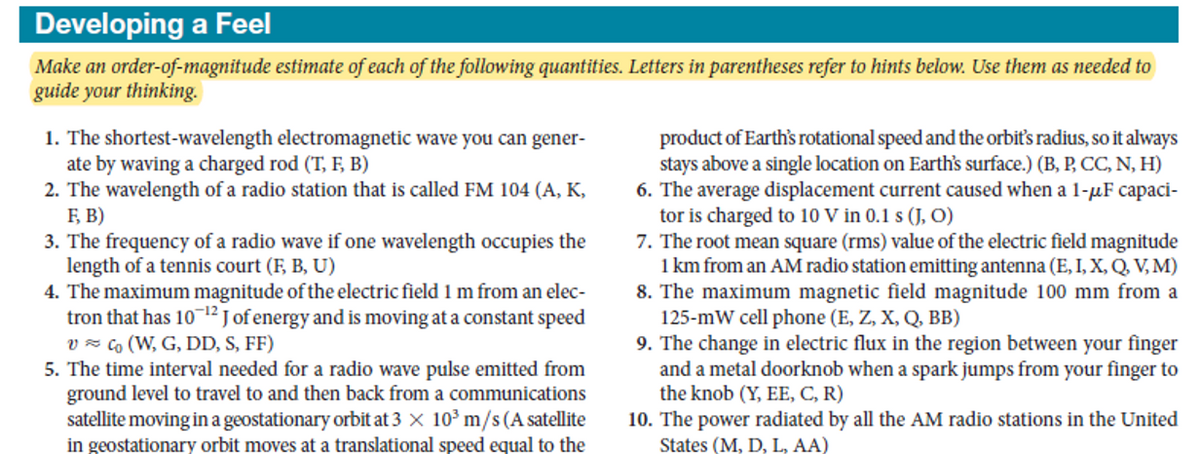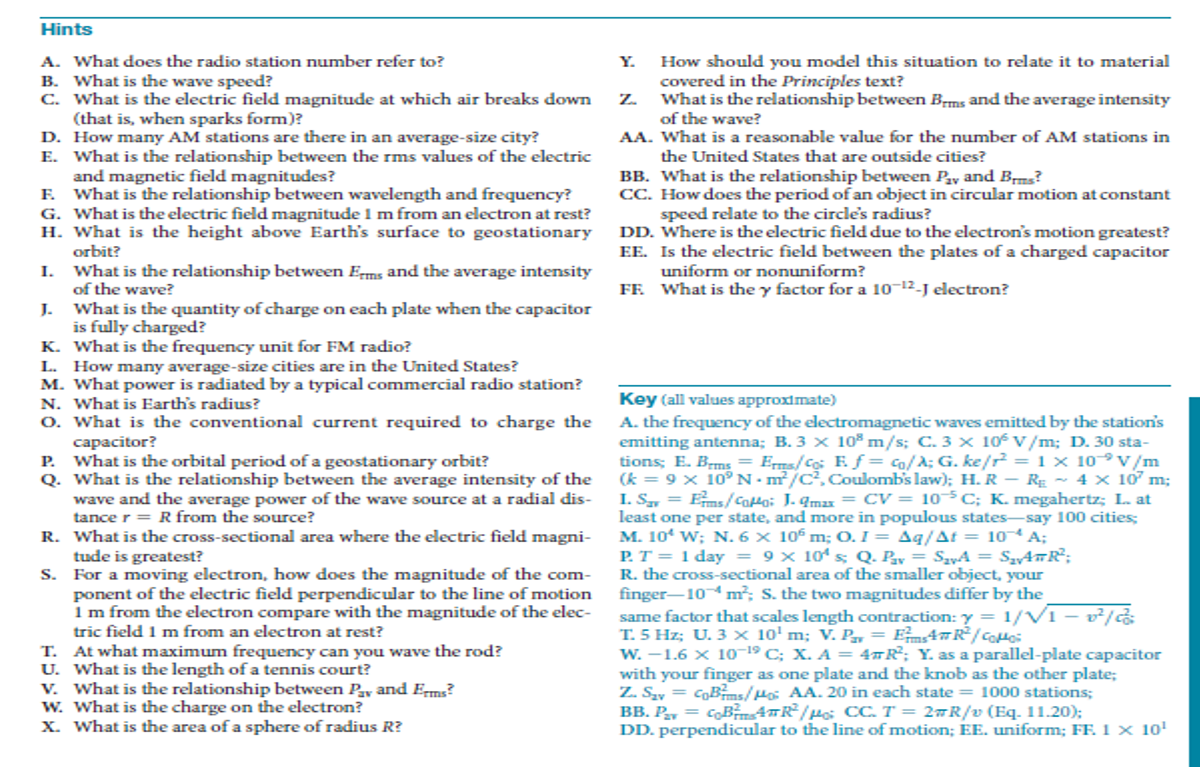4. The maximum magnitude of the electric field 1 m from an elec- tron that has 10¬² ] of energy and is moving at a constant speed V z Co (W, G, DD, S, FF) 5. The time interval needed for a radio wave pulse emitted from ground level to travel to and then back from a communications satellite moving in a geostationary orbit at 3 × 10³ m/s(A satellite Lit
4. The maximum magnitude of the electric field 1 m from an elec- tron that has 10¬² ] of energy and is moving at a constant speed V z Co (W, G, DD, S, FF) 5. The time interval needed for a radio wave pulse emitted from ground level to travel to and then back from a communications satellite moving in a geostationary orbit at 3 × 10³ m/s(A satellite Lit
Chapter6: Waves And Sound
Section: Chapter Questions
Problem 12Q
Related questions
Question
Please answer 4-6 only.

Transcribed Image Text:Developing a Feel
Make an order-of-magnitude estimate of each of the following quantities. Letters in parentheses refer to hints below. Use them as needed to
guide your thinking.
1. The shortest-wavelength electromagnetic wave you can gener-
ate by waving a charged rod (T, F, B)
2. The wavelength of a radio station that is called FM 104 (A, K,
F, B)
3. The frequency of a radio wave if one wavelength occupies the
length of a tennis court (F, B, U)
4. The maximum magnitude of the electric field 1 m from an elec-
tron that has 10¬12 J of energy and is moving at a constant speed
v z Co (W, G, DD, S, FF)
5. The time interval needed for a radio wave pulse emitted from
ground level to travel to and then back from a communications
satellite moving in a geostationary orbit at 3 x 10° m/s(A satellite
in geostationary orbit moves at a translational speed equal to the
product of Earth's rotational speed and the orbit's radius, so it always
stays above a single location on Earth's surface.) (B, P, CC, N, H)
6. The average displacement current caused when a 1-µF capaci-
tor is charged to 10 V in 0.1 s (J, O)
7. The root mean square (rms) value of the electric field magnitude
1 km from an AM radio station emitting antenna (E, I, X, Q, V, M)
8. The maximum magnetic field magnitude 100 mm from a
125-mW cell phone (E, Z, X, Q, BB)
9. The change in electric flux in the region between your finger
and a metal doorknob when a spark jumps from your finger to
the knob (Y, EE, C, R)
10. The power radiated by all the AM radio stations in the United
States (M, D, L, AA)

Transcribed Image Text:Hints
How should you model this situation to relate it to material
covered in the Principles text?
A. What does the radio station number refer to?
B. What is the wave speed?
C. What is the electric field magnitude at which air breaks down
(that is, when sparks form)?
D. How many AM stations are there in an average-size city?
E. What is the relationship between the rms values of the electric
and magnetic field magnitudes?
F. What is the relationship between wavelength and frequency?
G. What is the electric field magnitude 1 m from an electron at rest?
H. What is the height above Earth's surface to geostationary
Y.
Z.
What is the relationship between Bms and the average intensity
of the wave?
AA. What is a reasonable value for the number of AM stations in
the United States that are outside cities?
BB. What is the relationship between Pay and Bms?
CC. How does the period of an object in circular motion at constant
speed relate to the circle's radius?
DD. Where is the electric field due to the electron's motion greatest?
EE. Is the electric field between the plates of a charged capacitor
orbit?
I. What is the relationship between Ems and the average intensity
of the wave?
uniform or nonuniform?
FF What is the y factor for a 10-12-J electron?
J. What is the quantity of charge on each plate when the capacitor
is fully charged?
K. What is the frequency unit for FM radio?
L. How many average-size cities are in the United States?
M. What power is radiated by a typical commercial radio station?
N. What is Earth's radius?
O. What is the conventional current required to charge the
capacitor?
P. What is the orbital period of a geostationary orbit?
Q. What is the relationship between the average intensity of the
wave and the average power of the wave source at a radial dis-
tance r = R from the source?
R. What is the cross-sectional area where the electric field magni-
tude is greatest?
S. For a moving electron, how does the magnitude of the com-
ponent of the electric field perpendicular to the line of motion
1m from the electron compare with the magnitude of the elec-
tric field 1 m from an electron at rest?
T. At what maximum frequency can you wave the rod?
U. What is the length of a tennis court?
V. What is the relationship between Pay and Erms?
W. What is the charge on the electron?
X. What is the area of a sphere of radius R?
Key (all values approximate)
A. the frequency of the electromagnetic waves emitted by the station's
emitting antenna; B. 3 x 10% m/s; C. 3 x 106 v/m; D. 30 sta-
tions; E. Bms= Ems/Co F f = c/A; G. ke/? = 1 × 10³V/m
(k = 9 x 10°N-m/c?,Coulombs law); H. R – RE ~ 4 x 10 m;
I. S, = Ems/Cato: J. qmax = CV = 105C; K. megahertz; L. at
least one per state, and more in populous states-say 100 cities;
M. 10 w; N. 6 × 10° m; O.I= Aq/At = 10 A;
P. T = 1 day = 9 x 10 s; Q. Py = SzyA = S¼A™R²;
R. the cross-sectional area of the smaller object, your
finger-10 m²; S. the two magnitudes differ by the
same factor that scales length contraction: y = 1/V1 – v²/c
T. 5 Hz; U. 3 × 10' m; V. P,= Ems47R/CoHos
W. -1.6 × 10-19 C; X. A = 4#R; Y. as a parallel-plate capacitor
with your finger as one plate and the knob as the other plate;
Z. Szy = C„Bms/Ho AA. 20 in each state = 1000 stations;
BB. P, = cBms4R/Ho CC. T = 2#R/v (Eq. 11.20);
DD. perpendicular to the line of motion; EE. uniform; FF. 1 × 10'
Expert Solution
This question has been solved!
Explore an expertly crafted, step-by-step solution for a thorough understanding of key concepts.
Step by step
Solved in 4 steps with 4 images

Knowledge Booster
Learn more about
Need a deep-dive on the concept behind this application? Look no further. Learn more about this topic, physics and related others by exploring similar questions and additional content below.Recommended textbooks for you


Glencoe Physics: Principles and Problems, Student…
Physics
ISBN:
9780078807213
Author:
Paul W. Zitzewitz
Publisher:
Glencoe/McGraw-Hill

University Physics Volume 1
Physics
ISBN:
9781938168277
Author:
William Moebs, Samuel J. Ling, Jeff Sanny
Publisher:
OpenStax - Rice University


Glencoe Physics: Principles and Problems, Student…
Physics
ISBN:
9780078807213
Author:
Paul W. Zitzewitz
Publisher:
Glencoe/McGraw-Hill

University Physics Volume 1
Physics
ISBN:
9781938168277
Author:
William Moebs, Samuel J. Ling, Jeff Sanny
Publisher:
OpenStax - Rice University